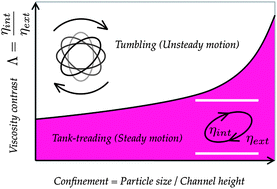How does confinement affect the dynamics of viscous vesicles and red blood cells?
Abstract
Despite its significance in microfluidics, the effect of confinement on the transition from the tank-treading (steady motion) to the tumbling (unsteady motion) dynamical state of deformable micro-particles has not been studied in detail. In this paper, we investigate the dynamics of a single viscous vesicle under confining shear as a general model system for red blood cells, capsules, or viscous droplets. The transition from the tank-treading to the tumbling motion can be triggered by the ratio between internal and external fluid viscosities. Here, we show that the transition can be induced solely by reducing the confinement, keeping the viscosity contrast constant. The observed dynamics results from the variation of the relative importance of viscous-, pressure-, and lubrication-induced torques exerted upon the vesicle. Our findings are of interest for designing future experiments or microfluidic devices: the possibility to trigger the tumbling-to-tank-treading transition either by geometry or viscosity contrast alone opens attractive possibilities for microrheological measurements as well as the detection and diagnosis of diseased red blood cells in confined flow.


 Please wait while we load your content...
Please wait while we load your content...